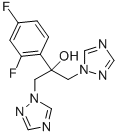- 0086-21-56469616
- 0086-18019205509
- minstar@minstargroup.com
- Language:English
- English
Your Location:Home >Products >Pharmaceutical >86386-73-4


Appearance:white to yellow-white crystalline powder
Throughput:40|Metric Ton|Month
pd_productuse: This product belongs to fluorinated triazole antifungal drug with the antifungal spectrum being similar as ketoconazole but antifungal activity being higher than ketoconazole. Its mechanism of action
Delivery Time:in stock
Purity:USP31
Uses This product belongs to fluorinated triazole antifungal drug with the antifungal spectrum being similar as ketoconazole but antifungal activity being higher than ketoconazole. Its mechanism of action is through inhibition of essential component of the fungal cell membrane, the ergosterol biosynthesis enzyme, blocking the ergosterol synthesis and breaking the integrity of the fungal cell wall, further inhibiting their growth and reproduction. The product has potent antifungal activity against Candida albicans, Microsporum canis, Cryptococcus neoformans, histoplasma capsulatum and epidermophyton.
Production method Method 1: From reaction between the formamide, hydrazine hydrate and 85% formic acid, we can obtain 1H-1, 2, 4-triazole. From phenylenediamine, we can obtain difluorobenzene, which is further subject to bromination to generate 2, 4-difluoro-bromobenzene. Magnesium was dissolved in anhydrous diethyl ether and added drop wise of the diethyl ether solution of 2, 4-difluoro-bromobenzene under ultrasonic irradiation, followed by adding drop wise of the diethyl ether solution of 1, 3-dichloroacetone under ice-cooling condition. Stir at room temperature overnight. Add glacial acetic acid and water. The separated organic layer was dried and concentrated. Concentrate, triazole, potassium carbonate and PEG600 were dissolved in anhydrous ethyl acetate and were subject to reflux. Then filter, wash with water to neutralization and dryness. The solvent was distilled off and was further subject to cyclohexane-ethyl acetate (1: 1) recrystallization to obtain the fluconazole with the overall yield being 33.6% and the m.p. being 138.5-140 ℃.
The last step can also be carried out in propionitrile. 1, 3-dihalo (x = Br or Cl)-2-(2, 4-difluorophenyl)-2-propanol and 1H-1, 2, 4-triazol-propionitrile were put into propionitrile and subject to reflux under the catalysis of sodium hydroxide and PEG 600 phase transfer catalysis and obtain the fluconazole crude product. The crude product was dissolved in fatty alcohols (such as propanol, isopropanol or butanol, etc.), dissolved upon heating with a small amount of active carbon for decoloring and then cooled to give crystals which is the refined product of fluconazole with the melting point being 139~140 ℃.
Method 2:2: 2, 4-difluorophenyl methyl is reacted with the Grignard reagent of 1-chloromethyl-1, 2, 4-triazole, and hydrolyzed to obtain fluconazole.
Method 3: difluorophenyl is subject to bromination to generate 1-bromo-2, 4-difluorobenzene, and then further converted to Grignard reagent. The resulting Grignard reagent above is reacted with 1, 3-bis (1H-1, 2, 4-triazole group) acetone, followed by hydrolysis to give fluconazole.
Chemical Properties White to Off-White Solid
Uses Labelled Fluconazole (F421000). Used as an antifungal.
Uses anticholinergic
Uses For the treatment of fungal infections.
Biological Activity Triazole antifungal agent. Effective against Candida strains in vitro and in vivo .
CAS:517920-73-9
CAS:881681-00-1
CAS:699-03-6
CAS:95-74-9